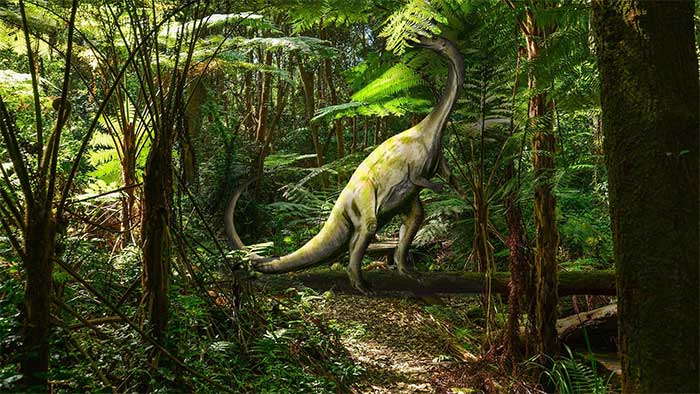American and South African scientists have recently unveiled the mystery surrounding a peculiar creature with a forelimb bone that is not much larger than a human bone, discovered in South Africa 36 years ago.
According to Sci-News, the research led by paleontologist Kimberley Chapelle from the American Museum of Natural History and the University of Witwatersrand in South Africa has identified a new Jurassic dinosaur species, tentatively named Massospondylus carinatus.
This discovery is based on a “forgotten fossil in the museum”, which is a forelimb bone excavated from South Africa back in 1987.

Graphic representation of Massospondylus carinatus – (Image: Nobu Tamura/SCI-NEWS).
This fossil indicates that the new species weighed approximately 75 kg, which is equivalent to that of an adult male. This weight makes it an “anomaly” during its time, living 195 million years ago in the Jurassic “era of monsters,” filled with giant dinosaurs.
There were other species that were similarly small or even smaller, but most were not dinosaurs.
“Shockingly,” this creature belongs to a group of dinosaurs known as Sauropodomorphs, meaning “lizard-footed dinosaurs“.
A popular representative of this group is the long-necked, long-tailed dinosaurs with massive, pillar-like legs that weighed dozens of tons, roaming during the Jurassic and Cretaceous periods. The Sauropodomorphs of the “theropod“ branch could weigh up to 90 tons.
Despite this, the newly identified creature remains a Sauropodomorph with a morphology similar to theropods, although its body is somewhat more “slender” and it may have stood on two legs in certain circumstances, based on the reconstructed imagery.
Additionally, it is considered an ancestor of the later giant Sauropodomorphs, serving as a link between two eras. Sauropodomorphs first evolved during the Carnian period (233-231 million years ago) of the Triassic (pre-Jurassic) as small, omnivorous species weighing less than 15 kg.
They evolved so rapidly that by 190-199 million years ago, at the very beginning of the Jurassic, they had already reached a common weight exceeding 10 tons and became herbivores.
The new creature Massospondylus carinatus represents the most unusual example, seemingly “falling back” from a previous era. However, this very characteristic makes it a remarkable representative and an intriguing connection between the small and gigantic phases of this dinosaur lineage.


















































